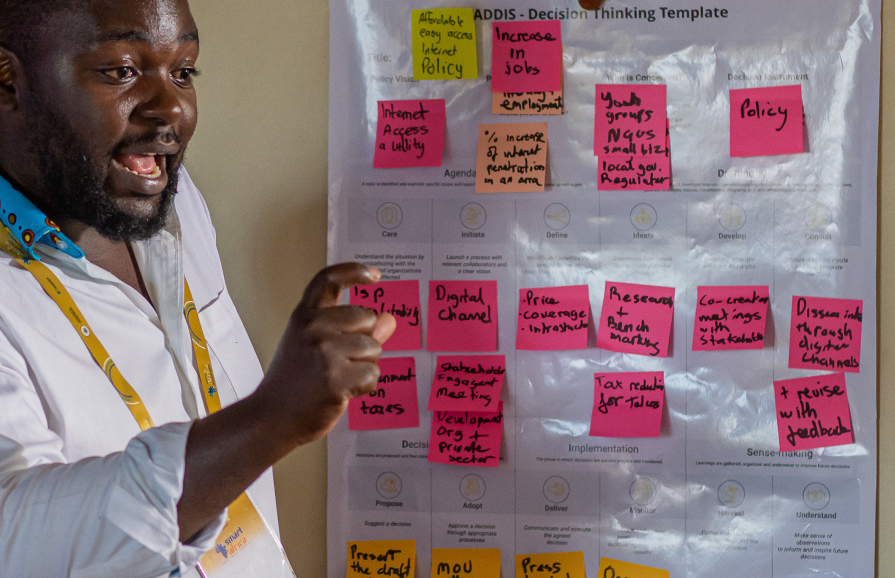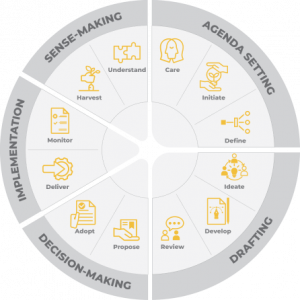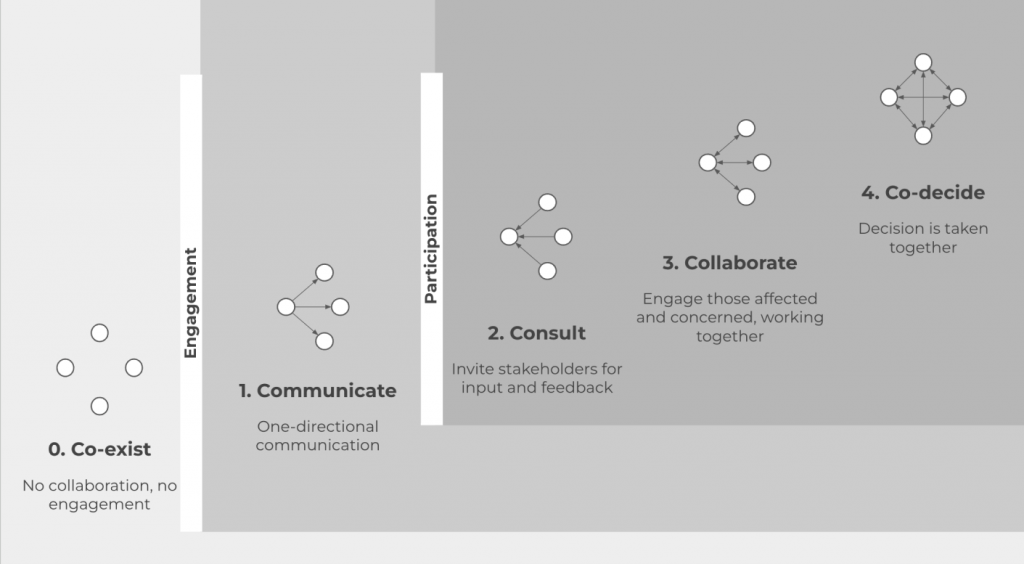Participatory Activity Canvas
Welcome to the Participatory Activity Canvas, a tool designed to support your journey in creating participatory processes at any level. The Canvas offers a step-by-step approach and visual reference to guide you through the critical questions involved in designing any participatory process. Within each section of the Canvas, you will find additional resources and reflections to deepen your understanding of each step.

Overview of the Participatory Activity Canvas
This Canvas have been developed based on i4Policy’s experience in supporting governments and community-based organizations to organize democratic innovations in more than 80 countries, as well as our work implementing transnational democratic innovations, such as coordinating the world’s first global citizens’ assembly.
1. Purpose: Topic
Determine the 'why' for your participatory process. It may be useful here to consider the 17 Sustainable Development Goals (SDGs) established by the United Nations in 2015 as part of the 2030 Agenda for Sustainable Development.
3. Stakeholders & Roles
Map the various stakeholders and identify their interests and needs, as well as their power dynamics, and overall relationships. Then, clearly define the roles needed to ensure the integrity and effectiveness of your participatory process.
5. Level of Engagement
Consider the extent to which you intend to engage and empower the participants of your process. The '5Cs of Collective Action' is a framework developed to help you characterize the level of engagement/participation.
Detailed overview of the Participatory Activity Canvas
When planning a participatory process, an important question to address is its purpose. Understanding why we are initiating the process is important for determining objectives and setting expectations.
There are various reasons for organizing a participatory activity, and a key step is to determine the topic: what issue needs to be addressed?
Topics can vary, and often a problem involves more than one topic. Thinking carefully about the topic when designing participatory activity ensures that the process is relevant, enables effective participant engagement, fosters high-quality deliberation, and leads to impactful outcomes (Chen, et al, 2024). It is essential to select topics that resonate with the public and hold significance for the community to ensure the effectiveness of the process.
Tip: The 17 Sustainable Development Goals (SDGs) established by the United Nations in 2015 as part of the 2030 Agenda for Sustainable Development can be a good starting point to identifying the topic of your participatory process.
We’ve organized dozens of cases from Participedia and Latinno according to the SDGs targeted to support you in finding references and inspirations.
The next step is to decide which design options the entire process will have. Usually a participatory process aims to influence a stage of public and collective decision-making. To achieve this, consider employing the ADDIS – Decision Thinking model as a guide to identify the desired outcomes. Determine at which phase of this process the participatory activity should take place, and envision the desired outcomes.

1. Agenda Setting: Identify and prioritize issues to address
- Care: to understand the people concerned by a decision area.
- Initiate: to launch a process to address a particular issue along with collaborators.
- Define: to identify and prioritize the specific issues, problems or opportunities, to be addressed.
2. Drafting: Potential solutions and strategies are developed
- Ideate: to explore, brainstorm, benchmark and evaluate potential solutions.
- Develop: to transform potential solutions into draft decisions.
- Consult: to share drafts for inputs and to then integrate feedback.
3. Decision-Making: The most viable path forward is chosen
- Propose: is to suggest a decision be taken.
- Adopt: to consider and approve a decision through an appropriate process.
4. Implementation: Decisions are put into practice and monitored
- Deliver: to communicate and execute the agreed decision.
Monitor: to track and assess implementation of a decision against desired results.
5. Sense-making: Reflect on outcomes which will then inform future decisions.
- Harvest: to gather insights from implementation and the overall process.
Understand: to make sense of observations, to inform and inspire future decisions.
We’ve organized dozens of cases from Participedia and Latinno according to the SDGs targeted to support you in finding references and inspirations.
Activities and initiatives that bring people together during a policy-making process differ widely according to who organizes the event and who is able to participate. Therefore, in developing a participatory activity, it is necessary to (i) identify stakeholders, (ii) understand their interrelationships, and (iii) define clear roles filled by each stakeholder group.
- Who are the key stakeholders involved?
A key aspect of the development of participatory activities is to map out and analyze the stakeholder ecosystem concerning the respective purpose of the activity, to identify the broad spectrum of actors involved. For this purpose, it is important to ask oneself who is involved with, affected by, and/or interested in the respective policy process. In answering this question, it will be possible to have a comprehensive understanding of who the key stakeholders are, and how they are related to the subject matter. This exercise will provide a basis to determine (i) who should host the activity, (ii) who should be included in the activity for it to achieve its goals, and (iii) which roles these stakeholders will have in the process.
- Who should host the activity?
With the stakeholder map in hand, the next step on the development of a participatory activity is to determine who is better positioned to host the participatory process. This is a crucial step in devising an effective strategy to ensure its success, especially considering that the legitimacy of these actors can significantly impact the credibility of the process. In essence, it entails the assessment of the power dynamics between the stakeholders (Gaventa, 2006). The spectrum of power dynamics range from top-down to bottom-up processes:
- Top-down: The process is initiated by a specific institution. Here, the central question revolves around how citizens are engaged in a policy-making process conducted by the institution.
- Bottom-up: The process is designed and driven by citizens, either independently or jointly with institutions, to influence or take part in the decision-making of a particular issue or cycle of public policy.
This spectrum of power dynamics offers a broad range of options for positioning participatory activities across personal, institutional, and collective levels. A particularly useful tool for defining these positions is the concept of Political Spaces.
Political Spaces are moments, actions, opportunities, and channels where people work together to influence decisions, discourses, and relationships that affect their lives and their interests (Stever, 2023). Each space has its own purpose and differing participation drivers to achieve its goal, including:
- Closed Spaces: Convened by decision-makers. These are often traditional, formally mandated bodies. Participation is closed, restricted to elected politicians, bureaucrats, or hand-picked citizens.
- Invited Spaces: Convened by decision-makers. These spaces often feature curated invitations.
- Co-created Spaces: Convened and organized jointly by decision-makers and citizens. These spaces often feature open participation ranging from open-for-all to lottery selection.
- Supported Spaces: Political spaces organized by citizens and grassroots actors with support from decision-makers. These spaces often feature open participation ranging from open-for-all to lottery selection.
- Claimed Spaces: Political spaces independently organized by citizens, movements, and communities. These spaces often feature inclusive participation, but audiences may also be implicitly or explicitly restricted to members of a community.
We’ve organized dozens of cases from Participedia and Latinno according to the SDGs targeted to support you in finding references and inspirations.
- Who should be included in the activity to best achieve its purpose?
With a clear understanding of the stakeholders, their power dynamics, and the political spaces involved in the participatory process, the next step is to determine who should participate. This decision should be guided by the principles most relevant to achieving the activity’s purpose, for example:
- Inclusivity: Provides a wide reach and diverse discussion through the participation of as many voices as possible in the conversation, including representatives from all stakeholder groups and with particular emphasis on those from underrepresented communities.
- Representation: Offers insight into the views of a community by considering its current composition. This includes the proportions of the population in various categories such as age, education, ethnicity, gender, and other relevant factors.
- Lived experience: Examines issues from the perspective of those directly involved, treating participants as subject-matter experts and drawing on their real-life experiences for valuable insights.
- What roles will these stakeholders have in the process?
Different individuals may have varied roles and responsibilities throughout the process. Recognizing where each participant stands in the development and execution of the consultative process is crucial to define expectations clearly and organize tasks efficiently. Here are some key roles to consider when organizing roles of a participatory process:
- Hosts: Responsible for convening the participatory activity.
- Organizers: Responsible for planning, executing, and managing the participatory activity.
- Facilitators: Responsible for guiding and managing the participatory activity, ensuring smooth communication and active participation among participants.
- MC and Animator (Lead facilitator): The main facilitator who leads the session, maintains the flow of the discussion, and ensures engagement from participants in the plenary.
- Conductor: A facilitator experienced with the context is responsible for overseeing the “run of show” of the activity and adapting as circumstances change (for example, if the food is late, how would the program change to accommodate a shift in the lunch break timing). This role may be combined with the lead facilitator role.
- Small Group Facilitators: Trained individuals responsible for leading specific portions of the activity within breakout groups.
4. Participants: Individuals and/or groups of stakeholders included in the process through an invitation to actively take part in the participatory activity.
5. Observers: Individuals tasked with observing the proceedings of the workshop without actively participating. They may provide feedback or insights afterward.
- Evaluation: Monitoring and studying the process independently to assess its effectiveness and impact.
- Audit: Providing transparent accountability of the process to ensure the integrity and the well-being of participants.
- General Public / Others: Participants who are not directly actively involved in the process but are permitted to observe the participatory activity.
6. Other Roles:
- Developers of Information Materials: People in charge of creating informational materials such as presentations, handouts, and/or reports.
- Editors: Reviewing and refining inputs after each workshop to ensure clarity, accuracy, and coherence.
The next step in the creation of a participatory process is to determine how to engage the key stakeholders and ensure that they participate in the process. The choice of the most appropriate recruitment method for a particular case should be determined by the predefined purpose process, as the different recruitment methods will convey in various degrees of representativeness and diversity.
A diverse range of participants brings a wide range of perspectives, enriching the quality of deliberations and leading to more impactful discussions. Additionally, careful recruitment helps address power imbalances by ensuring marginalized or underrepresented groups have a voice, resulting in more equitable outcomes.
Here are five options of outreach methods:
- Open for All: Participation is open to anyone interested, regardless of background or affiliation. This approach is typically used for elections, referendums, traditional consultations, crowdsourcing, and large-scale e-democracy platforms.
- Direct Invitation: These approaches seek to directly invite affected or interested communities. This can be done in a formal sense by inviting representatives of stakeholders, which is sometimes referred to as a “stakeholder-based approach”. This is a common approach in the United Nations (UN) system where organizations are invited to observe or participate based on their formal consultative status, for example, with the UN Economic and Social Council (ECOSOC) Major Groups and other Stakeholders (MGoS). Direct Invitation can also refer to less formal targeting of individuals or groups within communities (sometimes in an attempt to bypass formal and informal representatives), or to inviting specific experts or “influencers”.
- Indirect (or Decentralized) Invitation: The invitation to participate is extended indirectly through stakeholder groups. This involves engaging local and/or topic-specific partners in the process, typically community-based organizations, to invite and/or convene their communities and communities of communities.
- Sortition Selection: Participation is determined based on random selection, or a lottery, with chosen individuals representing the demographic diversity on selected topics.
- Hybrid: Participation employs diverse methods and integrates them into various tactics to ensure greater representation, inclusivity, and engagement in the process. For example, one might mix some open-for-all recruitment with targeted recruitment.
We’ve organized dozens of cases from Participedia and Latinno according to the SDGs targeted to support you in finding references and inspirations.
- Chen, et.al. (2024). Recipes for Transnational Public Spheres, pp. 15-17, Section 2.D (How? Process Innovations from Transnational Deliberation)
- Fung (2006). Varieties of Participation in Complex Governance
- Peixoto & Spada (2023). Reflections on the representativeness of citizens’ assemblies and similar innovations
- Redman, Peixoto & Spada (2023). How representative is it really? A correspondence on sortition
This section encourages you to reflect on the question of the extent to which you intend to engage, and how much you intend to empower the participants of your activity. This helps facilitate the development of appropriate citizen engagement strategies based on and tailored to the decision-making context.
The 5Cs of Collective Action are a heuristic to help characterize the level of participation.
- Co-exist: Depicts one end of the spectrum, where there is no interaction or active relationship between decision-makers and citizens, as they co-exist independently in their own silos, without any means or infrastructure to collaborate.
- Communicate: Constitutes a one-directional relationship, originating from decision-makers to citizens, where citizens are informed and/or educated about topics and issues deemed as relevant by the decision-makers, contributing to a common understanding.
- Consult: Represents a hybrid interaction, standing between a one-sided and a two-way relationship, as decision-makers invite citizens to actively interact and contribute to the decision-making, through input, opinions and/or feedback, which will then be factored in and considered in the policy-making process.
- Collaborate: Indicates a reciprocal relationship, where decision-makers work together with citizens and stakeholders who are affected by and concerned with the respective topic and/or issue to participate on a stage of the policy-making process.
- Co-decide: Stands for the maximized participation end of the spectrum, where a multidirectional relationship takes place, and the decision-making power is equally distributed between decision-makers and citizens.
We’ve organized dozens of cases from Participedia and Latinno according to the SDGs targeted to support you in finding references and inspirations.
When designing a participatory process it is important to consider various frameworks and approaches to ensure it is effective and impactful.
This is an opportunity to consider what other factors might be critical to make sure that your activity achieves its purpose and is aligned with the values and principles behind the initiative.
You may also find it helpful to refer to other resources that have been designed to support the planning of a participatory process, such as the OECD Checklist for designing and planning a citizen participation process and the People Powered Participation Playbook
The objective of the storyboard is to create a clear, collaborative, and visual plan for the design options of your participatory process. A storyboard could be a useful tool to map out how your participatory process will look like.
The storyboard, originally a tool from the filmmaking industry, can be highly beneficial in the field of citizen engagement. A storyboard is a visual representation of how a story will play out, scene by scene. It’s made up of a chronological series of images, with accompanying notes. It’s similar to a roadmap, guiding the journey of storytelling from the beginning to the end.
Now, it’s time to break down your design choices from the previous sections into key steps. Sketch each step with simple drawings and/or short descriptions on the storyboard to clearly communicate the plan. Share this visual map with colleagues or key stakeholders involved in the process to gather their feedback and get started!
